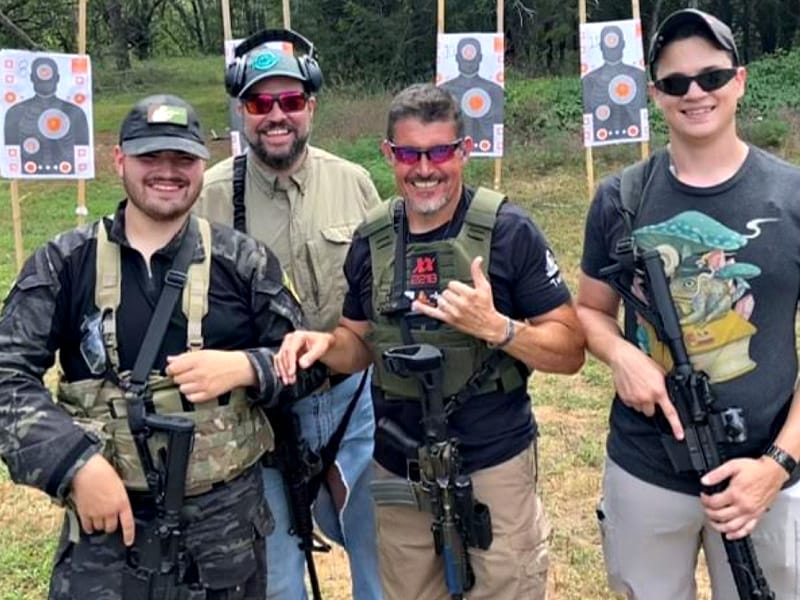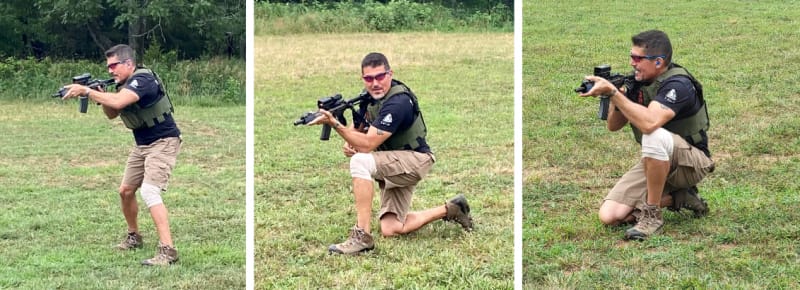Each year, a small group of senior instructors at Indy Arms Company sit down and plan out our training plans for the year. This year, one of the classes we chose was a carbine class with Kris ‘Tanto’ Paronto in Fort Scott, Kansas. Kris is a former U.S. Army ranger (75th Ranger Regiment) serving from 1995-2003 and then with the CIA from 2003-2013. Most famously, he was a part of the CIA Annex Security Team during the 2012 attack on the U.S. embassy in Benghazi, Libya. His experiences were related in the book “13 Hours: The Secret Soldiers of Benghazi” and he was played by Pablo Schreiber in the 2016 film “13 Hours.” Today, Kris is an author, public speaker, and lead instructor at Battleline Tactical.

None of our group had taken a class from Kris Paronto before and were looking forward to seeing how he incorporated his experiences into a primarily civilian class. Although I have not served, my fellow instructor served in the Marines and my son is currently serving in the 101st Airborne “Screaming Eagles.” Hearing Kris addressing them as “the Marine” and “Screaming Eagle” during the class was an added bonus.
From the moment Kris arrived on the range, his open style, charisma, and passion for instructing were all evident. He immediately discussed the importance of learning but also having fun and keeping a positive mood. There was no formal class/lecture-style instruction as we almost immediately started shooting after the safety brief focusing on muzzle, trigger, and safety and operating on a hot range.
Range and Overall Style of Instruction
The range was a large lead-free outdoor range with targets set up for each student (16), allowing shooting from seven to 50 yards (most drills were at 50 or 25 yards). Snacks and drinks were provided, but the facilities were the nearby tree line (though there was transport if anyone needed to use more ‘modern’ facilities).
Kris Paronto led the class, assisted by a few additional instructors. Kris would introduce each drill to the class and then make a very clear case for how each drill would provide the needed fundamentals and base to build onto for more advanced tactics. Kris would often demonstrate the proper way to complete the drill. His easy-going style was evident as he stated “Hey, we are all alpha males. We want to know why. We are going to ask questions. That is why I want to make sure you know the why of each drill.”

Once the drill was clear, we worked in pairs, with one shooting and one coaching. I have taken classes using this buddy system before, but it was done very well here. As the drill was being called (“threat”), Kris and the other instructors would check each shooter and occasionally provide corrections and feedback. What was interesting is that they would also give feedback to the coaches on what to look for to further improve the current shooter’s performance.
After each partner shot once and coached once, we would go as a group and check our targets. During this time, the instructors offered additional constructive feedback. Through this process of instruction, coaching, and instructing the coaches, simple drills were maximized for learning. I can honestly say this was one of the better classes I have taken, with a lot of drills and shooting (~250 rounds), but also clear instruction and feedback. Finally, each drill was very clearly built on the previous one.
Part I Drills: Open to Lunch
After a discussion of basic range commands and safety, Kris Paronto shared his thoughts on surviving encounters (the goal is not to be the best shot, or the fastest shot, but to be the best thinker — steps ahead of your opponents). Kris also discussed typical urban distances with a rifle (25-50 yards) as a basis for the ranges we were to work with.
To get everyone into the practice of the buddy system and range commands, the first series of drills focused on zeroing the rifles. We first shot three-round groups at 25 yards and then confirmed the zero with a few more three-shot drills at 50 yards. This was done through multiple drills generally from prone.
Once zeroed we proceeded to standing accuracy drills (generally two rounds per command) as Kris and the other instructors coached us on allowing the optic to flow and taking the shot as the optic settles on the target. We also worked on perfecting our squared stance allowing better visual range and a platform that better allowed for movement if needed.
Each drill from this point on started from a standing position, squared off towards the target, and at low ready (gun mounted and ready to fire with the sights just slightly below the shooter’s line of sight).

The remainder of the first part of the course was utilizing different shooting platforms (kneeling unsupported (or high kneeling), kneeling supported, and low supported kneeling). With each drill, we would start standing at low ready. At the call of “threat,” we would drop down into the required kneeling position and engage our target with two rounds, then with safety on we returned to a standing low ready position for the next call.
After doing this through the three kneeling positions as well as discussing the why and when of each position, we did a drill where the call of “threat” was immediately preceded by the kneeling position to use. As we prepared to break for lunch, Kris discussed the importance of using muscle on bone, or bone on muscle for supported shooting. For instance, you can place your elbow (bone) on your leg’s quadriceps (muscle) in a kneeling position.

Part II Drills: Lunch to End of Day
Kris hung out with the group talking during lunch and was very approachable. He discussed the need to “find, fix, and finish” when in a defensive situation. Kris also stressed the need for P.I.D. (positive identification), clearly identifying each target before engaging.
Our first drill after lunch was a simple two rounds per “threat” from standing at 25 yards but engaging two targets and taking the time to positively identify what we were shooting. We then moved on to bilateral shooting (right side and left side mounting). The first drill was just moving the rifle without switching out the grip from low ready when the “threat” command was given. We would come up from low ready shoot one round, engage the safety, transfer the gun from the right side to the left without changing our grip, engage with a second round, and then as we engaged the safety, return the carbine to the original shoulder at low ready.
After this drill, we repeated the process, including changing hands (right-handed trigger on right shoulder, left-handed trigger on left shoulder). We then did multiple failure-to-stop (two to the body, one to the head) and three head-shot-only drills, alternating between the right shoulder and left shoulder with each shot. These drills really helped to drive home the importance of a squared-off stance. We ended the live fire with transition drills focused on engaging a target from low ready, placing the carbine on safe, sweeping it safely out of the way, and drawing our handguns to re-engage the target. We did these drills both dry and live.
The final drill of the day was a single headshot from low-ready on signal in single elimination pairings. Accuracy (hit in the head bullseye) trumped speed, but if both people got a bullseye hit, speed was then the determining factor. I was paired with my son, who immediately eliminated me and made it to the semi-finals. After the last drill, Kris offered some final words of wisdom, praised the class in general, and welcomed us all to any of his other classes. The class ended with a chance to share a drink with Kris, certificates, and a choice of a bottle of Tanto vodka or a signed copy of the book “13 Hours.”

Conclusion
Although the drills and material presented were focused on the fundamentals, the clear communication of the importance of these fundamentals and the sequential nature of the class made this an enjoyable class regardless of your experience. Everyone in our group had experience with carbines, including many more ‘advanced’ classes, and yet all three of us agreed we gained a better understanding and usable tips that added to what we already knew.
There is no question we will be making the long drive (~8 hours) to train with Kris again in the future. Although clearly aimed at civilian self-defense, my currently serving son was impressed and was immediately talking up the class and experience with his fellow soldiers as soon as he was back on base.
Honestly, the only drawback of this class was that we were all wanting to do more when the class ended. It should also be noted that the facility is lead-free, and you will need to buy lead-free ammo to take one of these classes (Battleline Tactical can provide discount codes for ammo purchases). I would happily recommend this class for anyone interested in advancing their rifle skills to a more tactical level no matter your current skill level.


